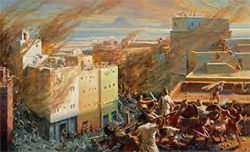The Punic Wars: Titanic Struggle in the Ancient Mediterranean
Part 5: The Third Punic War 
Surprisingly, Rome's terms were not all that harsh. The Carthaginian army and navy were vastly reduced, but Carthage was allowed to govern itself. Hannibal was even the head of the government for awhile. For a few years, now that Rome wasn't bent on its destruction, Carthage was allowed to thrive, even to rebuild its economy and its cities. Roman jealousy and desire for finality got the better of Rome in the end, however, and the government demanded that Carthage surrender Hannibal. He refused and, in 195, went into hiding, ending up in Syria as an adviser to King Antiochus III, who was planning a war with Rome. Antiochus wasn't the brightest of leaders, and he refused to take Hannibal's battlefield advice. The result was yet another Roman victory and yet another Hannibal escape, this time to Bithynia (which was in what is now Turkey). Roman armies found him eventually, in 183, and threatened to take him back to Rome as a criminal in chains. Rather than await this fate, Hannibal killed himself. Carthage remained an important trade center until Rome decided to destroy the city. By 151 B.C., Carthage had paid off the huge indemnity imposed on it at the end of the Second Punic War. By the terms of the agreement that ended that war, Carthage had to get permission from the Roman Senate to go to war with any neighbors. Carthage struggled repeatedly with border disputes involving the Numidians. A Numidian attack in 151 B.C. resulted in a Carthaginian counterattack, one not approved by Rome. Using that event as a pretext for war, Rome declared itself at war with Carthage for a third time, in 149 B.C. By this point, Carthage nowhere near the military presence that it had been; Rome, on the other hand, had grown in strength and capability. The Third Punic War was very much a one-sided affair. 
Rome insisted on a series of increasingly brazen conditions for not attacking Carthage. In the meantime, longtime Carthaginian ally Utica threw in its lot with Rome and allowed a Roman army of 80,000 to enter the city. The final indignity, according to Carthaginian officials, was that Rome demanded that all the citizens of Carthage move 10 miles inland, so that Rome could burn the ancient city. Carthage refused, and Roman soldiers surrounded the city and settled in for a siege. Carthage scored a few early victories, repulsing a number of Roman attacks and damaging the Roman fleet by releasing fire ships into their midst. However, a fresh assault led by Scipio Aemilianus in 146 B.C. overwhelmed an exhausted, starving populace and Rome took the city. Roman soldiers burned the city for more than two weeks, reducing it to ash. Whatever other territories that Carthage still owned became part of the Roman Province of Africa. First page > A Clash of Influences > Page 1, 2, 3, 4, 5 |
|
Social Studies for Kids
copyright 2002–2026
David White




